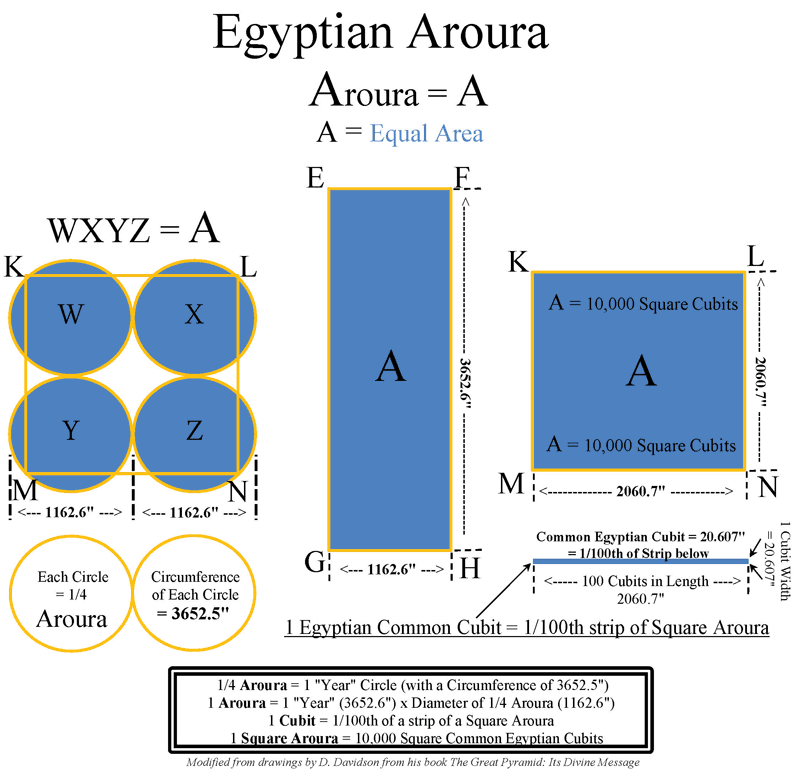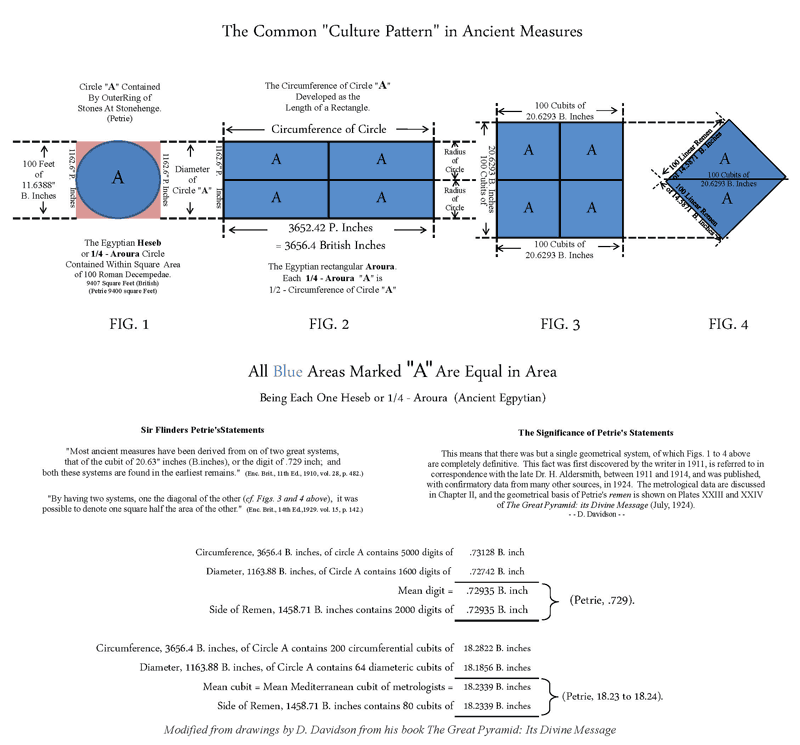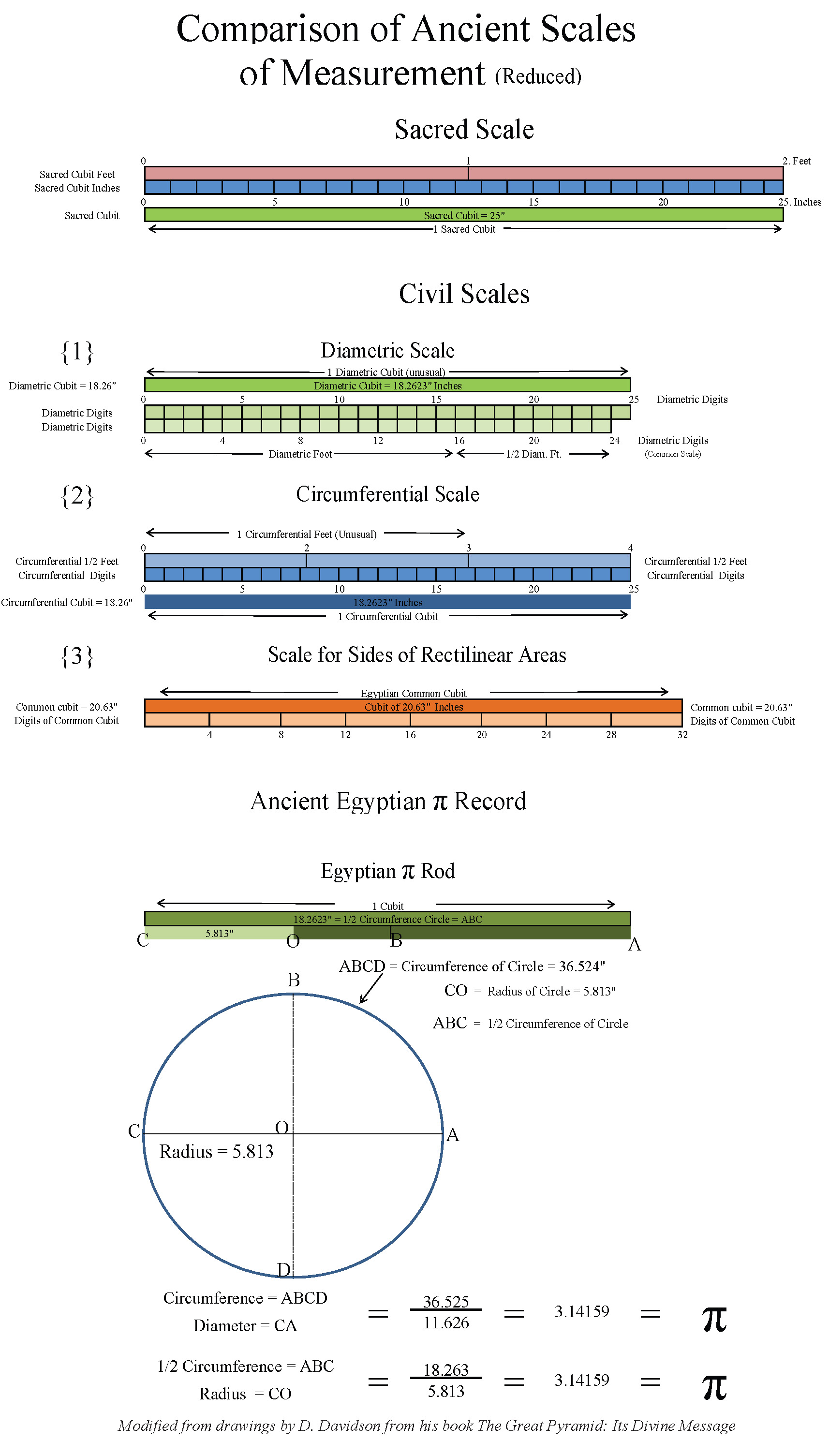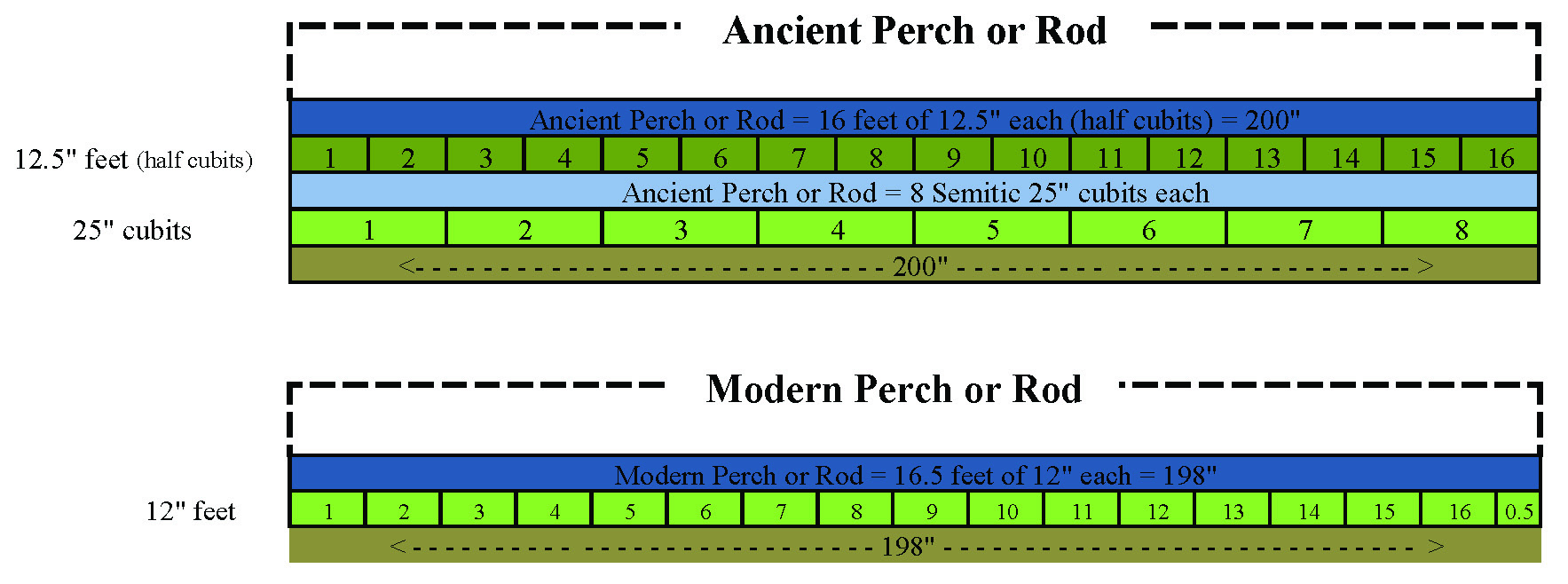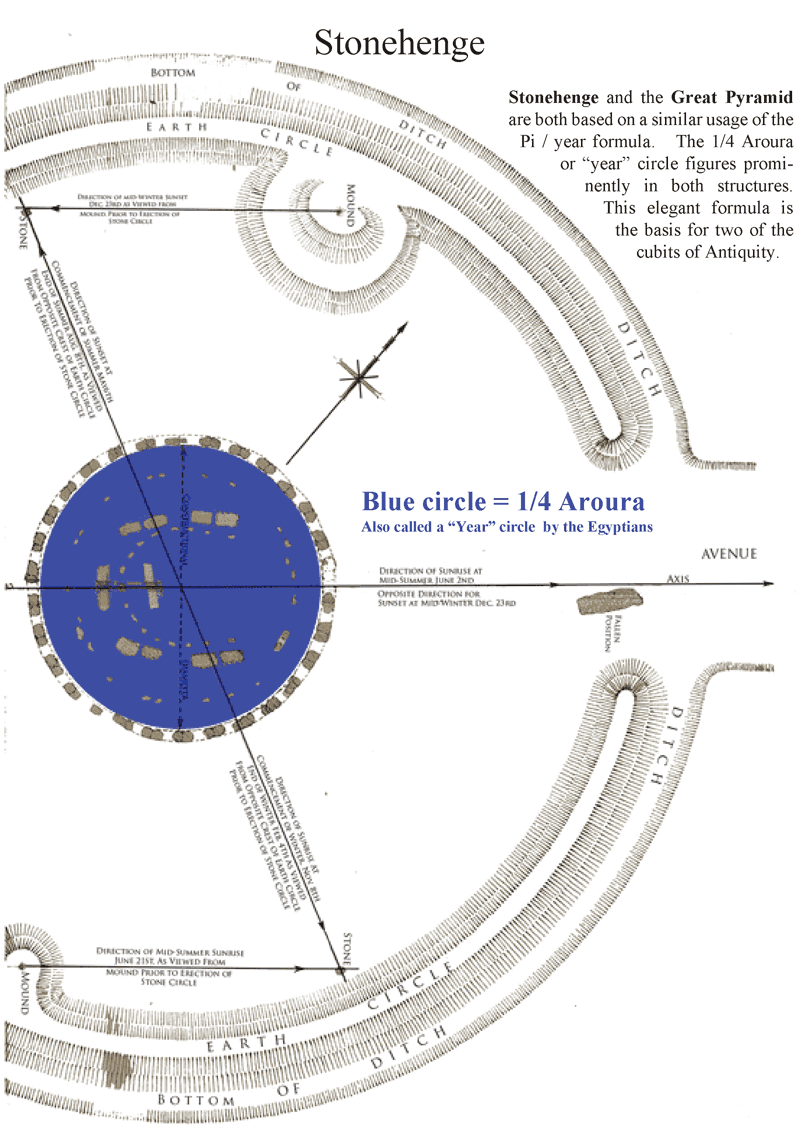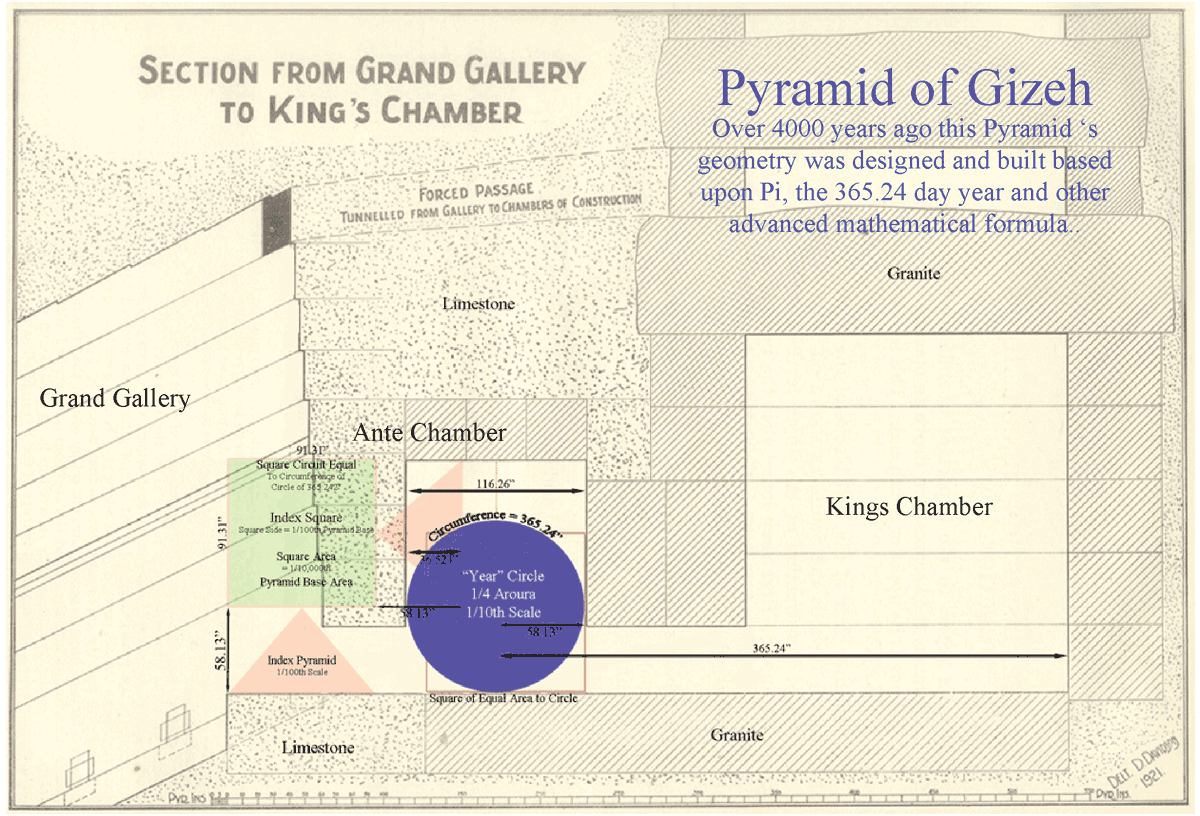Author’s Note: Since my teenage years I’ve loved to investigate subjects which are related in some way to ancient history and the Bible. During the late 19th century and the early 20th century there was much interest and many books written about the Great Pyramid. Many of these books claimed the Great Pyramid was an ancient chronograph and contained hidden scientific knowledge. Some even claimed a connection to Biblical history. I don’t intent to discuss the veracity of those claims in this current article but I would like to address a related subject.
The subject of this current article is the origins of the ancient cubit and its relationship to linear measure and geometry. Many of the ideas in this present essay have their origins in those books from the turn of the 19th century. I have tried to condense and simplify some of the ideas and principles. I can only take credit for trying to refresh some of their great research. After over 20 years of investigation I am humbled by how ignorant we are of the past. I am equally astounded by how much those ancient “primitive” civilizations knew. As this article will demonstrate those civilizations used advanced mathematical concepts in normal everyday life, concepts that modern science did not “discover” until thousands of years later. So without further introduction I hope you enjoy:
The Ancient Origins of the Cubit: Its Basis in Linear Measure and Geometry
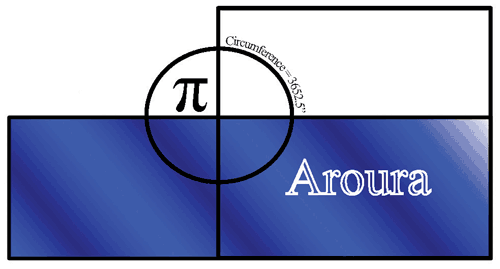
The cubit is a unit of measure which was used across the ancient world. It was defined by a unit of measure related to our modern inch. While the exact date and origin of the inch based system has not been determined in history, it is represented in almost every culture with only a very slight variation over thousands of years. Interestingly, the original primitive “inch” seems to have represented a fraction of the polar diameter of the earth. It is approximately a 1/500,000,000th fraction of this polar diameter. Pretty amazing considering its antiquity.
Up until the French revolution the inch based system was without rival. It is the basis for the foot, yard, furlong, cubit, mile, and numerous other specific measurements. The table below was compiled by Piazzi Smyth. It is found in his book The Great Pyramid. He was the astronomer-royal for Scotland in the late nineteenth century. His list shows the value of the inch in various cultures as a fraction of the foot. Our modern inch today is closely related to the British inch. One of the oldest surviving representation of the inch is found in the Pyramid of Gizeh. The entire system of geometry represented in this ancient structure is based on an inch. This ancient or for lack of a better term “primitive” (P) inch is equal to P = 1.0011” British inches. Ancient Greece is credited with the discovery of modern mathematics and geometry. But upon close examination each “great” Greek scholar was “inspired” only after a period of time spent in Ancient Egypt. The fact of the matter is that ancient Egypt showed a knowledge of Pi and other complex mathematical relationships long before the Greeks showed up and borrowed the ideas. Some of Egypt’s most basic linear and square measures are derived from Pi.
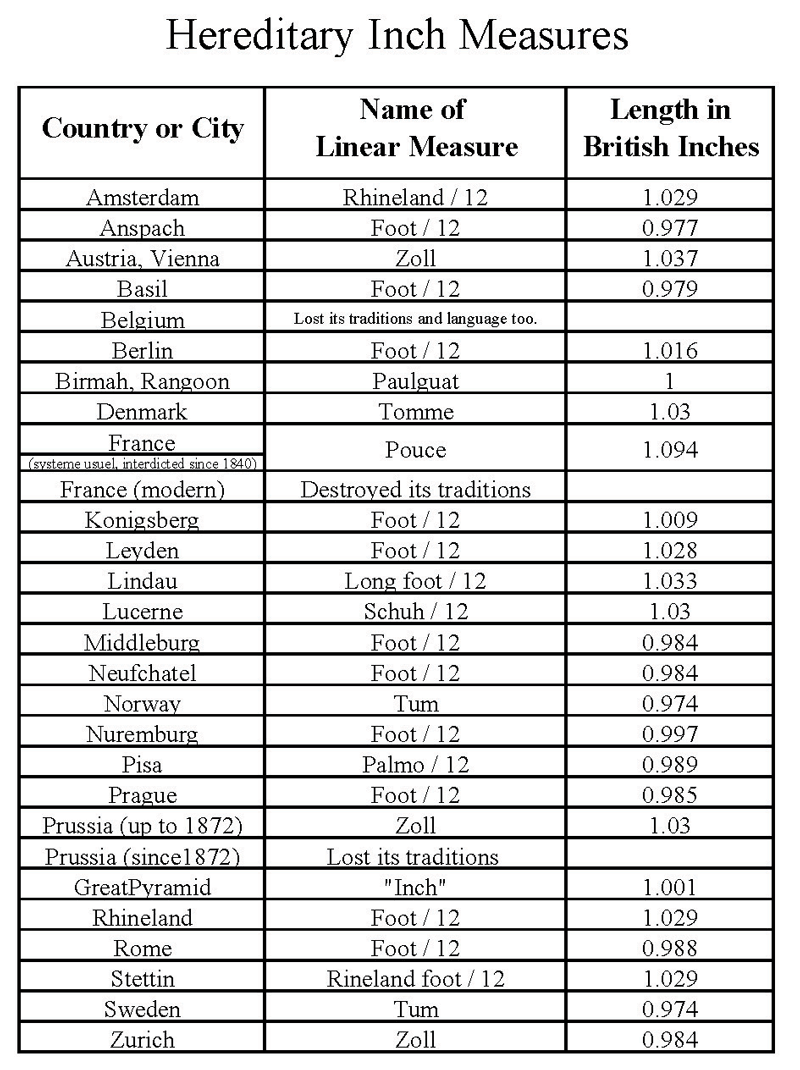
Today one of the most misunderstood and confused measurements of ancient origin is the cubit. Some claim the cubit is approximately 18”, while others claim 20”. Most evidence today points to a variation of one of these two measurements. In ancient Egypt there is also evidence of another cubit of 25”. According to Petrie and others this cubit saw use when Egypt was under Semitic influence.
The two most widely recognized forms of the cubit are merely an expression of the relationship between the year of 365.25 days and pi. (3.14159). In ancient Egypt the Aroura was an area measurement equal to the expression of this relationship. In Egypt the year was sometimes called a quarter (1/4). This “quarter” was the geometrical expression of a circle whose circumference was 3652.5”. This circle or “quarter” had a diameter of 1162.6” and was equal to a “quarter” of an Aroura. 4 of these “quarters” were equal to 1 Aroura. In order to further simplify this relationship a rectangle Aroura of 1162.6 P” x 3652.5 P” was developed. This rectangle was the equivalent area measure of 4 of the 1/4 Aroura circles. This rectangular Aroura was then expressed as a square Aroura of 2060.7” x 2060.7”. A linear cubit was then derived from 1/100th of the side of this square Aroura. A square cubit was equal to 1/10,000th of this square Aroura. The following table expresses these relationships.
The second cubit used in ancient Egypt was also a variation on the relationship between the 365.25 day year and Pi. This cubit was the Egyptian Pi “rod” cubit or circumferential cubit. This cubit or rod measurement was a fractional measure of half the circumference of this 1/4 Aroura “year” circle of 3652.5”. This linear cubit measure was equal to 18.2625” and was a linear expression of the relationship between the radius of a “year” circle and its circumference. The next two tables show the means by which the Pi / year relationship was expressed and the means by which both cubits were derived. They also show the relationship between these Egyptian cubits and their inch and diametric divisions.
Horapollo in his Hieroglyphics, Bk I, v. stated the following concerning the relationship between the Egyptian year and the Aroura: “To represent the current year, they (the Egyptians) depicted the fourth part of an aroura: now the aroura is a measure of land of an hundred cubits. And when they would express a year they say a quarter.”
Hereodotus makes a similar statement: “the aroura is a square of a hundred cubits, the Egyptian cubit being the same as the Samian.”
As you can see the cubit of 20.607” and 18.26” both had origins in practical geometry and linear measure. Most cubit approximations today are based on one of these two cubits. A cubit then is a linear measure expressing the relationship between the 365.25 day year and Pi. This relationship is the reason the ancient Egyptians sometimes expressed the year in hieroglyphics as either a square or a circle.
The evidence for a sacred cubit of Semitic origins is compelling as well. It is claimed by Davidson and others that Mr. Flinders Petrie, the eminent Egyptologist, found that the 25” cubit was used in Egypt during the XVIII Dynasty. (I have not been able to verify this claim as a reader graciously pointed out to me recently.) This was a period of time when the Egyptian culture was heavily influenced by Semitic culture. According to him the 25” cubit is only found during periods of Semitic influence. Mr. Petrie also found the half-cubit or “foot” appeared in Babylonia as a foot of 12.5”. In Greece this “foot” was 12.44-12.62 B” (British inches) in Eturia it averaged 12.47 B”.
In the 10th century the “foot” was shortened to 12”. This became the legal foot since that time. For an extended period of time the 12” legal foot competed with the old half-cubit foot (12.5”) of antiquity. Evidence for this is found in several places but one of the most compelling modern examples is found on the statue of Richard I from 1199 AD. An inscription on this statue defines an acre as follows: “40 perches in length and 4 in breadth and every perch of 16 feet in length”
According to this inscription the perch was only 16 feet in length. A modern perch on the other hand is 16.5 feet in length. The discrepancy is obvious when it is realized that a foot at the time of this inscription was 12.5” in length while the modern foot was shortened to only 12”. Therefore the perch at the time of Richard I was 200” in length while the modern perch is 198”. The modern perch being lengthened so that it could maintain its value (within 1%) relative to the inch as defined by the shortened 12” foot.
It is interesting to note that Sir Isaac Newton had a great interest in the length of the cubit. His interest it seems was based upon his belief that the cubit and by extension the inch were relative to the astronomical measurements he needed to confirm his gravitational theories. Isaac Newton in his Dissertation on Cubits narrowed the value of the Hebrew or “Sacred Cubit” to approximately 23-27” in length. He used the following 7 points to arrive at his conclusion. All values are calculated in British inches. 1 British inch = 1.0011 primitive inches.
1. By investigation of Talmudist’s and Josephus’ in reference to the Greek cubit he calculated the range of the Hebrew cubit to 24.3 – 31.24”
2. From Talmudist’s proportion to the human body 23.28 – 27.94”
3. From Josephus’ description of the pillars of the Temple 23.28 – 27.16”.
4. By calculation of a Sabbath days journey 23.28 – 27.16”
5. By Talmudist’s and Josephus’ description of the Inner Court 23.28 – 26.19”
6. By proportion to the Chaldaic and Hebrew cubit to that of the cubit of Memphis 24.83”
7. Statement of Mersennus as to a supposed copy of the “sacred cubit of the Hebrews” 24.91”
Newton’s calculations show it is very likely that the Hebrew sacred cubit was 25” . This would agree with Petrie statements as to the Semitic origins of the 25” cubit in ancient Egypt. This 25” cubit is inferred in the Egyptian record (shown in the table above) by the division of their cubit into 25 diametric units. This division into 25 diametric units likely facilitated the conversion of the cubit between the Egyptian and Semitic units of measure.
The use of a 25” cubit as evidenced by the 12.5” (half cubit) foot in Babylon, Europe, and the British Isles could well be explained by the Semitic migration from Mesopotamia and Egypt. The famous Stonehenge is but a large scale representation of these relationships. The outer stone ring as measured by Petrie gives a diameter of 1168 British inches. Thus showing a 1/4 Aroura fits precisely inside the outer stone circle. Contrary to popular belief today, Stonehenge was not originally designed as a place of occult religious practice. Quite to the contrary, it showed the advanced nature and understanding of that early civilization. They designed and built with stone a highly accurate structure showing the relationship between linear measure, plane geometry, Pi, and the solar year. This circle of stones created a type of mammoth astronomical almanac. This almanac gives precise mathematical and astronomical calculations which mankind was not fully able to appreciate or understand again until our modern era, thousands of years later.
In summary then, the cubits of ancient Egypt were used as both a linear and square measure which eloquently expressed the relationship between the solar year of 365.25 days and Pi. Both cubit measures express an advanced knowledge of mathematics and geometry as well as an awareness of advanced astronomical relationships. It is also apparent that an additional cubit of 25” was used at times in Egyptian history during periods of Semitic influence. The origin and basis for this cubit are not as clear. Based on existing evidence though, it seems the 25” cubit was used in places were Semitic influence was prevalent. This 25” cubit likely being one of the cubits used by the Hebrew people in the Biblical record.
1. Primitive inch = 1.0011 British inches
2. 12.5” = 1 Primitive Foot
3. 25” = 1 Semitic Cubit
4. A primitive Perch or Rod = 16 feet, each foot of 12.5”
5. A primitive Perch or Rod was equal to 200 primitive inches
6. A primitive Perch or Rod was = to 8 Semitic cubits
7. 40 Perch or Rod = 1 furlong
8. 8000 primitive inches = 1 primitive furlong
9. 8 furlong = 1 mile
10. 1 mile = 64000 primitive inches
11. 320 Semitic cubits = 1 furlong
12. 2560 Semitic cubits = 1 mile

